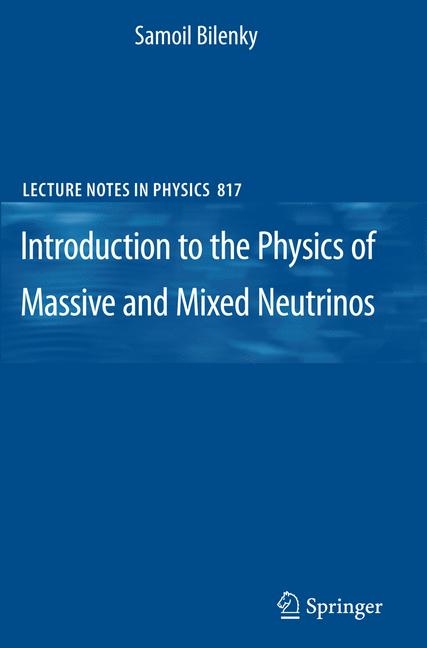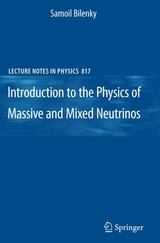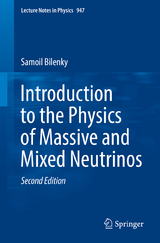Introduction to the Physics of Massive and Mixed Neutrinos
Seiten
2010
|
2010
Springer Berlin (Verlag)
978-3-642-14042-6 (ISBN)
Springer Berlin (Verlag)
978-3-642-14042-6 (ISBN)
- Titel erscheint in neuer Auflage
- Artikel merken
Zu diesem Artikel existiert eine Nachauflage
This gentle but detailed introduction to the physics of massive and mixed neutrinos is based on the author's lectures. It aims to prepare graduate students and young researchers entering the field for the exciting years of neutrino physics to come.
For many years neutrino was considered a massless particle. The theory of a two-componentneutrino,whichplayedacrucialroleinthecreationofthetheoryof theweakinteraction,isbasedontheassumptionthattheneutrinomassisequalto zero. We now know that neutrinos have nonzero, small masses. In numerous exp- iments with solar, atmospheric, reactor and accelerator neutrinos a new p- nomenon, neutrino oscillations, was observed. Neutrino oscillations (periodic transitionsbetweendifferent?avorneutrinos? ,? ,? )arepossibleonlyifneutrino e ? ? mass-squareddifferencesaredifferentfromzeroandsmalland?avorneutrinosare "mixed". The discovery of neutrino oscillations opened a new era in neutrino physics: an era of investigation of neutrino masses, mixing, magnetic moments and other neutrino properties. After the establishment of the Standard Model of the el- troweak interaction at the end of the seventies, the discovery of neutrino masses was the most important discovery in particle physics. Small neutrino masses cannot be explained by the standard Higgs mechanism of mass generation. For their explanation a new mechanism is needed. Thus, small neutrino masses is the ?rst signature in particle physics of a new beyond the Standard Model physics. It took many years of heroic efforts by many physicists to discover n- trino oscillations. After the ?rst period of investigation of neutrino oscillations, manychallengingproblemsremainedunsolved.Oneofthemostimportantisthe problem of the nature of neutrinos with de?nite masses. Are they Dirac n- trinos possessing a conserved lepton number which distinguish neutrinos and antineutrinos or Majorana neutrinos with identical neutrinos and antineutrinos? Many experiments of the next generation and new neutrino facilities are now under preparation and investigation. There is no doubt that exciting results are ahead.
For many years neutrino was considered a massless particle. The theory of a two-componentneutrino,whichplayedacrucialroleinthecreationofthetheoryof theweakinteraction,isbasedontheassumptionthattheneutrinomassisequalto zero. We now know that neutrinos have nonzero, small masses. In numerous exp- iments with solar, atmospheric, reactor and accelerator neutrinos a new p- nomenon, neutrino oscillations, was observed. Neutrino oscillations (periodic transitionsbetweendifferent?avorneutrinos? ,? ,? )arepossibleonlyifneutrino e ? ? mass-squareddifferencesaredifferentfromzeroandsmalland?avorneutrinosare "mixed". The discovery of neutrino oscillations opened a new era in neutrino physics: an era of investigation of neutrino masses, mixing, magnetic moments and other neutrino properties. After the establishment of the Standard Model of the el- troweak interaction at the end of the seventies, the discovery of neutrino masses was the most important discovery in particle physics. Small neutrino masses cannot be explained by the standard Higgs mechanism of mass generation. For their explanation a new mechanism is needed. Thus, small neutrino masses is the ?rst signature in particle physics of a new beyond the Standard Model physics. It took many years of heroic efforts by many physicists to discover n- trino oscillations. After the ?rst period of investigation of neutrino oscillations, manychallengingproblemsremainedunsolved.Oneofthemostimportantisthe problem of the nature of neutrinos with de?nite masses. Are they Dirac n- trinos possessing a conserved lepton number which distinguish neutrinos and antineutrinos or Majorana neutrinos with identical neutrinos and antineutrinos? Many experiments of the next generation and new neutrino facilities are now under preparation and investigation. There is no doubt that exciting results are ahead.
Weak Interaction Before the Standard Model.- The Standard Model of the Electroweak Interaction.- Neutrino Mass Terms.- Neutrino Mixing Matrix.- Neutrino Oscillations in Vacuum.- Neutrino in Matter.- Neutrinoless Double Beta-Decay.- On absolute Values of Neutrino Masses.- Neutrino Oscillation Experiments.- Neutrino and Cosmology.- Conclusion and Prospects.
| Reihe/Serie | Lecture Notes in Physics ; 817 |
|---|---|
| Zusatzinfo | XIII, 256 p. 12 illus. |
| Verlagsort | Berlin |
| Sprache | englisch |
| Maße | 155 x 235 mm |
| Gewicht | 410 g |
| Themenwelt | Naturwissenschaften ► Physik / Astronomie ► Allgemeines / Lexika |
| Naturwissenschaften ► Physik / Astronomie ► Atom- / Kern- / Molekularphysik | |
| Schlagworte | Beyond the standard model of particle physics • Dirac and Majorana particles • Experiment • Hardcover, Softcover / Physik, Astronomie/Allgemeines, Lexika • Lepton • Neutrino • Neutrino Astrophysics • Neutrino masses and oscillations • Particle physics |
| ISBN-10 | 3-642-14042-4 / 3642140424 |
| ISBN-13 | 978-3-642-14042-6 / 9783642140426 |
| Zustand | Neuware |
| Haben Sie eine Frage zum Produkt? |
Mehr entdecken
aus dem Bereich
aus dem Bereich
Band 1: Mechanik und Thermodynamik
Buch | Softcover (2022)
Wiley-VCH (Verlag)
CHF 55,85
für Studierende der Naturwissenschaften und Technik
Buch | Hardcover (2024)
Springer Spektrum (Verlag)
CHF 109,95





